Party-Plan Fashion
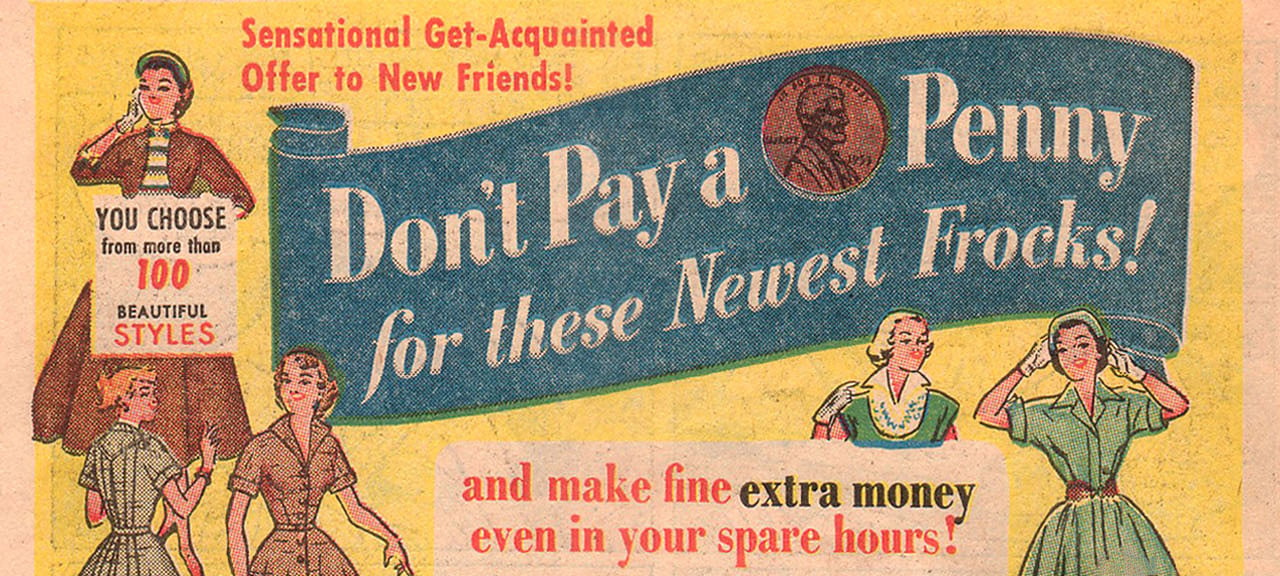
Harford Frocks Advertisement
In the world of fashion, good ideas travel fast, and when ready-to-wear fashion and bored housewives combined with businesses willing to adapt their selling styles, it became a recipe for success.
Fashion Frocks (and its division Harford Frocks) was one of the companies in the early decades of the twentieth century who springboarded off the idea of using women who buy a product to sell the same product to other women of their acquaintance. But while Harford Frocks utilized a resource many other companies did not - women - they weren’t the party plan model as it is understood today. The company recruited women in droves, but retained the familiar practice of selling door-to-door as a mode of selling wares. It would take a new paradigm to emerge to change how women saw themselves in the business world.
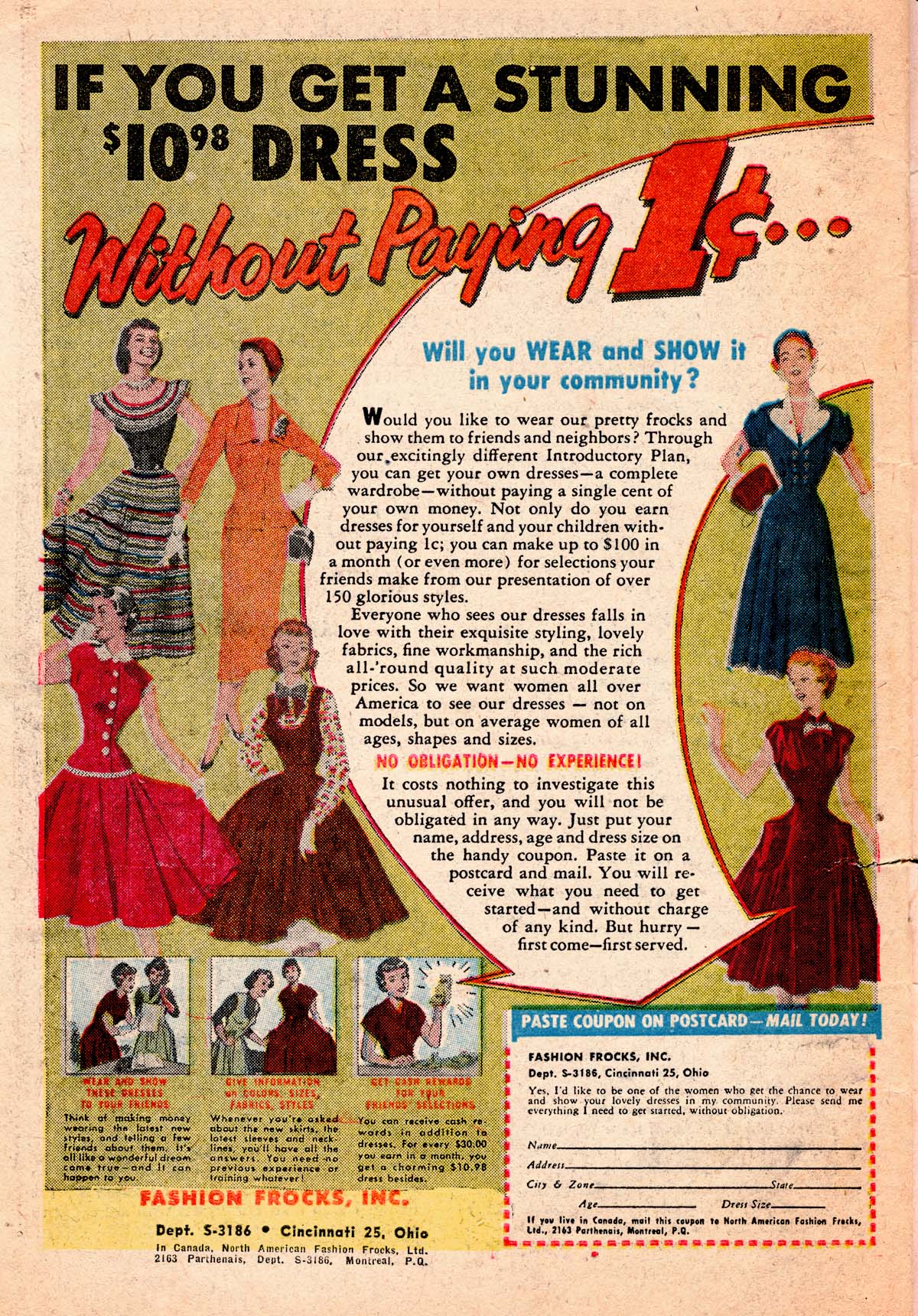
Fashion Frocks Advertisement
During World War II, women were moved into the workforce to fill shortages left by men who had gone overseas to fight. For many of these women, these jobs represented their first taste of independence; they quickly grew accustomed to earning a wage and working outside the home. After men returned home from the war, however, these women found themselves consigned once again to the roles of housewife and mother. They were a prime market just waiting for companies with direct-sales models to tap.
1950s Harford Frocks label from the FC Label Archive.
Enter the party-plan model of sales. Party-plan selling came into being in the late 1930’s, when Norman Squires, a door-to-door salesman, became frustrated with knocking on hundreds of doors daily without the guarantee of making any sales. He decided to encourage neighbors to get together for coffee, where he could display his wares. He later presented his idea to Frank Stanley Beveridge, founder of Stanley Home Products, who decided to use the concept to separate his business style from his competitors.
One of the first of many companies to combine this marketing potential with fashion was Dutchmaid. Founded in the midst of the Great Depression by W. H. Fake, a Pennsylvania doctor who worried many of his patients couldn’t make ends meet, Dutchmaid moved from door-to-door to the party-plan style of selling as early as 1948. Dutchmaid manufactured hosiery and underwear, but when his customers kept asking him if he had dresses, too, he decided to expand into party sales. He provided fashion catalogues with material swatches and sample dresses for his Fashion Stylists to use when they planned their parties for their friends.
1970s Dress by Beeline Fashions, from Style & Salvage.
The same year, Beeline Fashions - founded in 1945 by H. Edison and Beatrice ‘Bee’ Birginial in their basement - decided they, too, would transition fully to the party plan. Before founding the company, Bee Birginal had often invited her friends over to her house to show some of her designs. Beeline thus encouraged their saleswomen to call their parties “Home Style Shows.”
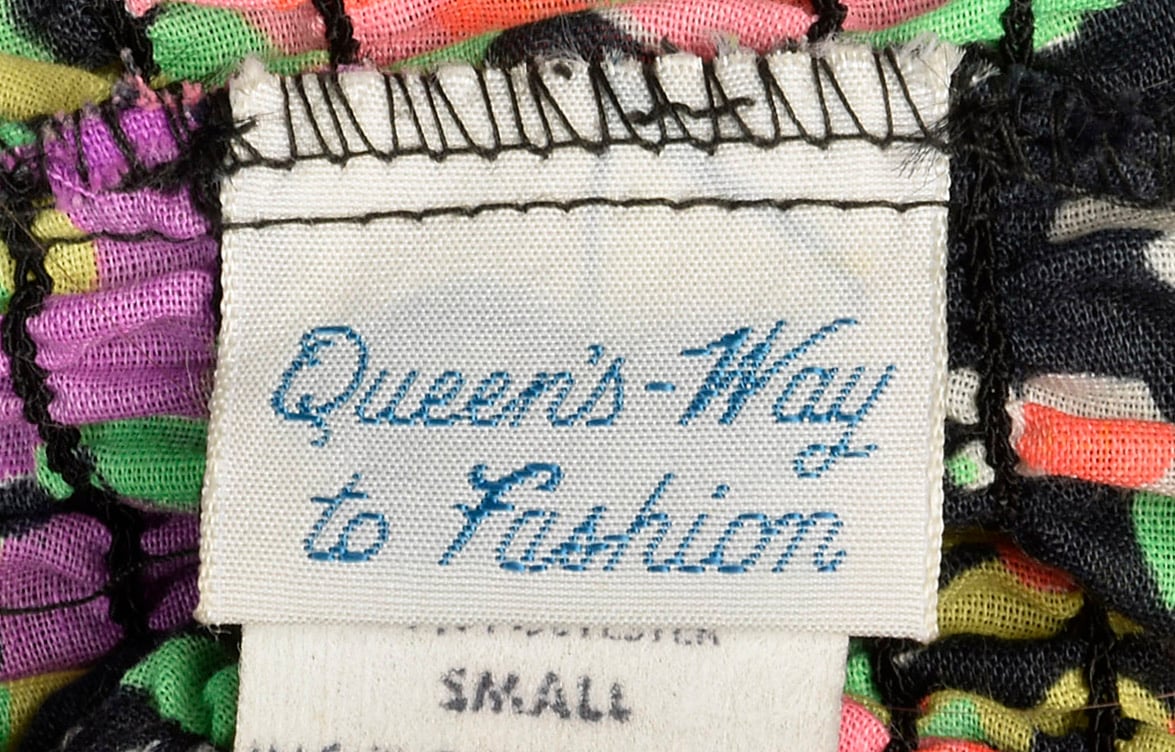
In 1952, Queen’s-Way to Fashion entered the party plan market, followed by the Minnesota Woolen Company of Duluth’s Fashion Wagon in 1960. All of these companies provided incentives for their representatives and the hostesses who opened their homes to friends and neighbors for fashion parties. Gifts were common; some were offered stainless steel tableware sets, lamps, or the company’s latest designs. Representatives were also rewarded for meeting or exceeding sales goals with vacations and prizes.
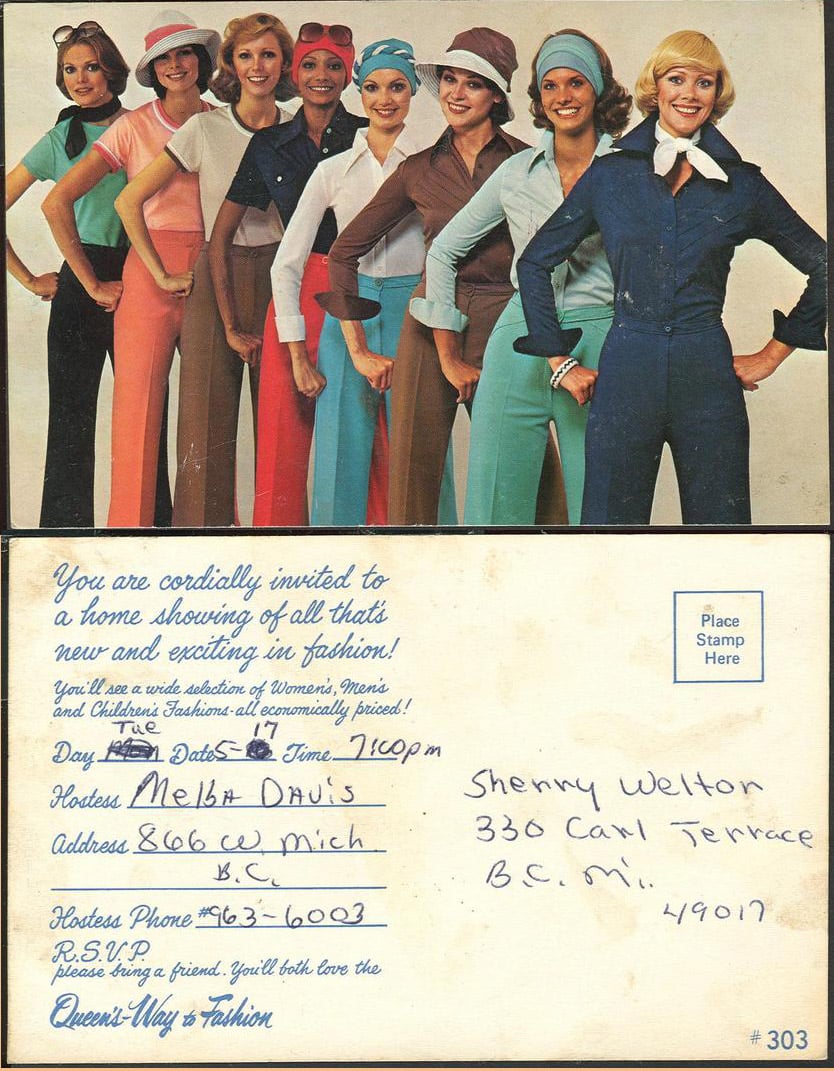
Queen's-Way to Fashion postcard invitation
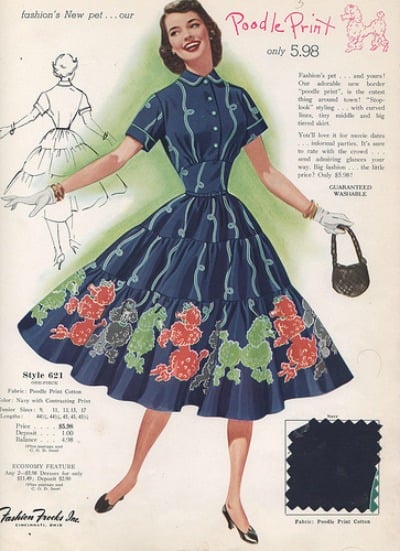
Fashion Frocks Advertisement
None of these companies ventured into the fringes of the fashion world. While their garments were often made with quality materials, they were primarily moderately-priced lines of men’s, women’s and children’s fashions. Garments were styled and chosen for their flexibility. Hard-to-fit items or those extreme in style weren’t offered due to a customer’s inability to return items. Most items were lightweight knits and most dresses were in shift styles. Sportswear was coordinated. Slacks, skirts, blouses and jackets were designed to be interchangeable so the customer would get more value for their dollar. Universally, designs were attractively touted as unique to each company and lines were rotated frequently to encourage women to buy the latest styles.
The post-war boom of the 1950’s and 1960’s saw the heyday of buying ready-to-wear fashions at home. The economic prosperity of these decades encouraged lifestyles which revolved around home entertaining, and home selling parties were perfect catalysts for social events as well as being pools from which to pull new prospective party-givers. Buying clothes from catalogs was difficult, and these parties helped women see and feel the clothes as they were modeled.
Large-scale shopping mall sprawl of the late 1970’s and early 1980’s, coupled with economic downturns, helped sound the death knell for party plan fashion. Fashion Wagon struggled under the one-two punch of declining sales and criminality behind the scenes and closed in 1977. Beeline was sold to a management group around 1984 and shuttered its manufacturing around 1987. Queen’s-Way to Fashion tried to pivot to a Columbia House Music Club-style of selling fashion through the mail by subscription with their Career Guild division, but ended up closing their doors around 1988. And while party plan fashion still exists to this day, it has yet to reach the peak it did in the post-war years.
Patricia Browning received her archivist degree in Information Management & Preservation from the University of Glasgow. Her lifelong fascination with research saturates nearly every aspect of her life. These days, when she's not nose-deep researching vintage fashion labels, she can be found doing geneology or working on her pet project, David Tennant's early theatre career in Scotland.
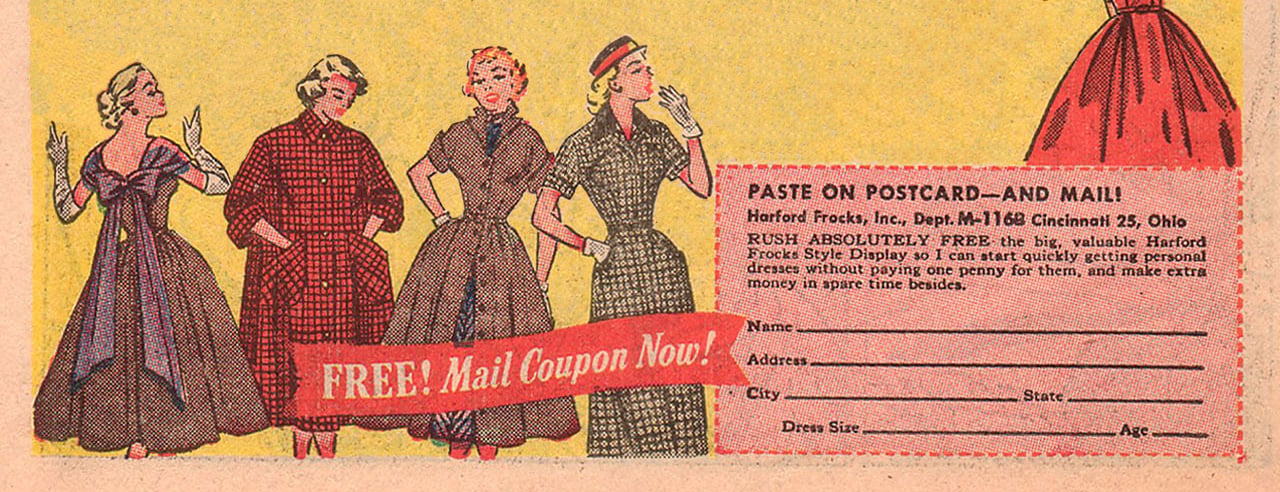
Harford Frocks Advertisement
References:
Adam, Pat. “Beeline’s Marge Pring: Fashion Buyer for Millions.” (24 April 1968.) The Roselle Register [Roselle, IL], p. A1, image 29. Retrieved 4 Aug 2021 via newspaperarchive.com.
Bogost, Ian (17 February 2018). “When Malls Saved the Suburbs from Despair.” Atlantic. Retrieved 6 Aug 2021.
Constable, Pamela. “Living room retailing: At home parties, the fun’s in the selling.” (29 July 1979). The Baltimore Sun [Baltimore, MD], pp. 1-2, images 185-6. Retrieved 2 Aug 2021 via Newspapers.com.
“Direct Selling Timeline.” Direct Selling Journal, Direct Selling Association, 2021.
Freilaufer. (2 October 2013). “Fashion Wagon - Minnesota Woolen.” Perfect Duluth Day.
Page, Dian. “Opening a garage door to success.” (12 June 1981). Green Bay Press-Gazette [Green Bay, WI], p. A9, image 9. Retrieved 2 Aug 2021 via Newspapers.com.
Salmans, Sandra. “Home Parties, Where the Selling is Easy.” (3 September 1981). The New York Times [New York, NY], p. C1, C6, images 46, 51. Retrieved 6 Aug 2021 via TimesMachine.
"Scientific Farmer’ Makes Success Selling Frocks.” (5 July 1929). Indianapolis Times [Indianapolis, IN], p. 12, image 12. Retrieved 16 Jul 2021 via newspaperarchive.com.
Stockbridge, Dorothy. “Happy Birthday Hawaiian Style.” (26 January 1979). Sarasota Journal [Sarasota, FL], p. D1, image 40, Retrieved 29 Jul 2021 via newspaperarchive.com.
Extras:
To see some lovely examples of Harford Frocks' sales cards, check out this post from The Vintage Traveler: Harford Frocks Sales Cards
